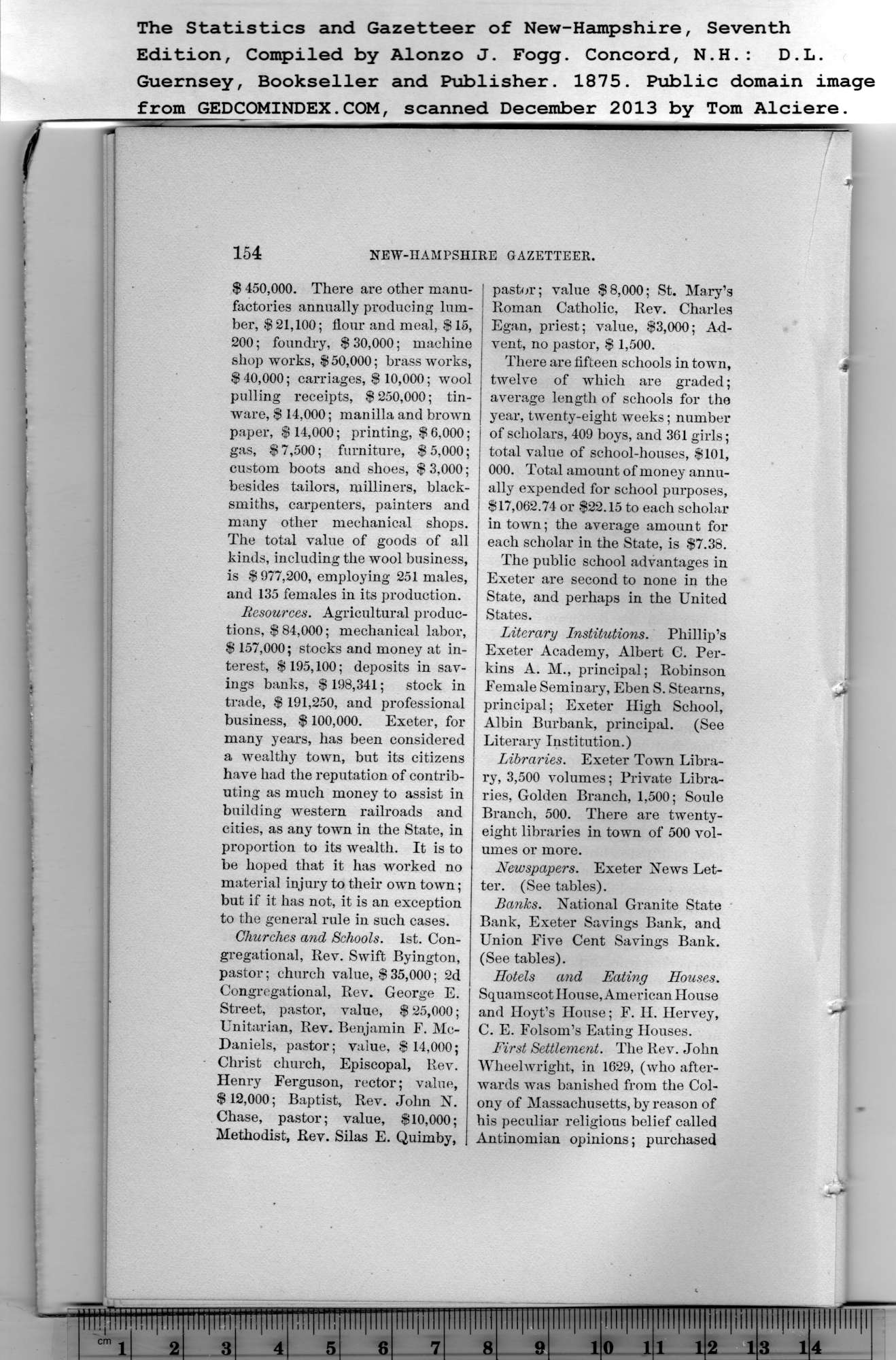|
$ 450,000. There are other manu-
factories annually producing lum-
ber, $ 21,100; flour and meal, $ 15,
200; foundry, $ 30,000; machine
shop works, $50,000; brass works,
$ 40,000; carriages, $ 10,000; wool
pulling receipts, $ 250,000; tin-
ware, $ 14,000; manilla and brown
paper, $ 14,000; printing, $ 6,000;
gas, $ 7,500; furniture, $ 5,000;
custom boots and shoes, $ 3,000;
besides tailors, milliners, black-
smiths, carpenters, paintei'S and
many other mechanical shops.
The total value of goods of all
kinds, including the wool business,
is $ 977,200, employing 251 males,
and 135 females in its production.
Resources. Agricultural produc-
tions, $ 84,000; mechanical labor,
$ 157,000; stocks and money at in-
terest, $ 195,100; deposits in sav-
ings banks, $ 198,341; stock in
trade, $ 191,250, and professional
business, $ 100,000. Exeter, for
many years, has been considered
a wealthy town, but its citizens
have had the reputation of contrib-
uting as much money to assist in
building western railroads and
cities, as any town in the State, in
proportion to its wealth. It is to
be hoped that it has worked no
material injury to their own town;
but if it has not, it is an exception
to the general rule in such cases.
Churches and Schools. 1st. Con-
gregational, Rev. Swift Byington,
pastor; church value, $ 35,000; 2d
Congregational, Rev. George E.
Street, pastor, value, $ 25,000;
Unitarian, Rev. Benjamin F. Mc-
Daniels, pastor; value, $ 14,000;
Christ church, Episcopal, Rev.
Henry Ferguson, rector; value,
$12,000; Baptist, Rev. John N.
Chase, pastor; value, $10,000;
Methodist, Rev. Silas E. Quimby,
pastor; value $8,000; St. Mary’s
Roman Catholic, Rev. Charles
Egan, priest; value, $3,000; Ad-
vent, no pastor, $ 1,500. |
There are fifteen schools in town,
twelve of which are graded;
average length of schools for the
year, twenty-eight weeks; number
of scholars, 409 boys, and 361 girls;
total value of school-houses, $101,
000. Total amount of money annu-
ally expended for school purposes,
$17,062.74 or $22.15 to each scholar
in town; the average amount for
each scholar in the State, is $7.38.
The public school advantages in
Exeter are second to none in the
State, and perhaps in the United
States.
Literary Institutions. Phillip’s
Exeter Academy, Albert G. Per-
kins A. M., principal; Robinson
Female Seminary, Eben S. Stearns,
principal; Exeter High School,
Albin Burbank, principal. (See
Literary Institution.)
Libraries. Exeter Town Libra-
ry, 3,500 volumes; Private Libra-
ries, Golden Branch, 1,500; Soule
Branch, 500. There are twenty-
eight libraries in town of 500 vol-
umes or more.
Newspapers. Exeter News Let-
ter. (See tables).
Banks. National Granite State
Bank, Exeter Savings Bank, and
Union Five Cent Savings Bank.
(See tables).
Hotels and Eating Houses.
Squamseot House, American House
and Hoyt’s House; F. II. Hervey,
C. E. Folsom’s Eating Houses.
First Settlement. The Rev. John
Wheehvright, in 1629, (who after-
wards was banished from the Col-
ony of Massachusetts, by reason of
his peculiar religions belief called
Antinomian opinions; purchased |
